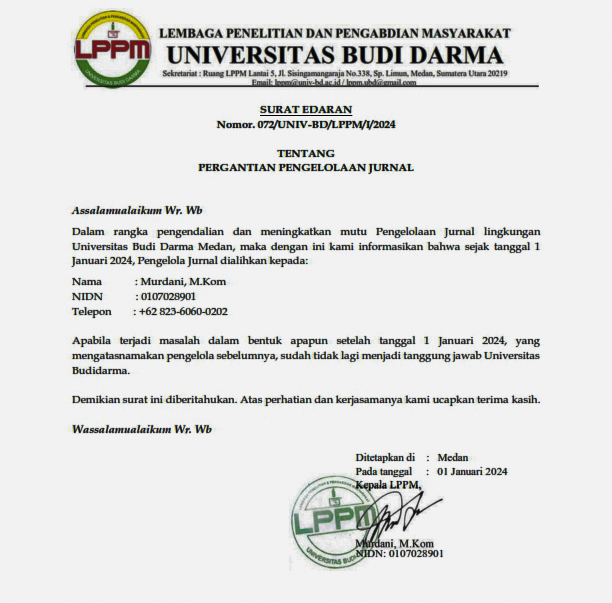Analisis Intensitas Cahaya Lampu Pijar dengan Menerapkan Metode Gray Level Co-occurence Matrik
DOI:
https://doi.org/10.30865/json.v4i2.5366Keywords:
GLCM, Extraction Feature, High Frequency, Low FrequencyAbstract
This paper proposes primary dataset with 13 images thermal capture, 8 high frequency and 4 low frequency. We utilize thermal images fluorescent lamp and using image processing with extraction feature GLCM method. Furthermore, Contrast, Correlation. Energy, Homogeinity dan sudut 0°, 45°, 90°, 135°, these feature texture using for calculated validation compare with both exsperiment qualitative results in Table1 and Table2. Therefore, exsperiment with fluorescent lamp Figure 2 quantitative results significant in Table1. Quantitative results with fluorescent lamp in Table2 extraction feature GLCM method with angle 0°, 45°, 90°, 135° and in Table1 quantitaive result with low frequency 50 Hz with T (oC) 50 is significantly robust. Comparable quantitative results in Table2 with low frequency 50 Hz from extraction feature mean value angle 0°, 45°, 90°, 135° Contrast (0.0363), Correlation (0.9959), Energy (0.1353), and Homogeneity (0.9832).
References
B. Hardiansyah and Y. Lu, “Single image super-resolution via multiple linear mapping anchored neighborhood regression,†Multimed. Tools Appl., vol. 80, no. 19, pp. 28713–28730, 2021, doi: 10.1007/s11042-021-11062-0.
Y. Hendrawan et al., “Development of colour co-occurrence matrix (CCM) texture analysis for biosensing,†IOP Conf. Ser. Earth Environ. Sci., vol. 230, no. 1, 2019, doi: 10.1088/1755-1315/230/1/012022.
E. H. Rachmawanto, C. A. Sari, Y. P. Astuti, and L. Umaroh, “A robust image watermarking using hybrid DCT and SLT,†Proc. - 2016 Int. Semin. Appl. Technol. Inf. Commun. ISEMANTIC 2016, pp. 312–316, 2017, doi: 10.1109/ISEMANTIC.2016.7873857.
A. Setyono, D. R. I. M. Setiadi, and Muljono, “StegoCrypt method using wavelet transform and one-time pad for secret image delivery,†Proc. - 2017 4th Int. Conf. Inf. Technol. Comput. Electr. Eng. ICITACEE 2017, vol. 2018-Janua, no. January 2018, pp. 203–207, 2017, doi: 10.1109/ICITACEE.2017.8257703.
G. Harshvardhan, N. Venkateswaran, and N. Padmapriya, “Assessment of Glaucoma with ocular thermal images using GLCM techniques and Logistic Regression classifier,†Proc. 2016 IEEE Int. Conf. Wirel. Commun. Signal Process. Networking, WiSPNET 2016, pp. 1534–1537, 2016, doi: 10.1109/WiSPNET.2016.7566393.
R. A. Saputra, Suharyanto, S. Wasiyanti, D. F. Saefudin, A. Supriyatna, and A. Wibowo, “Rice Leaf Disease Image Classifications Using KNN Based on GLCM Feature Extraction,†J. Phys. Conf. Ser., vol. 1641, no. 1, 2020, doi: 10.1088/1742-6596/1641/1/012080.
C. Perdahci, H. C. Akin, and O. Cekic, “A comparative study of fluorescent and LED lighting in industrial facilities,†IOP Conf. Ser. Earth Environ. Sci., vol. 154, no. 1, 2018, doi: 10.1088/1755-1315/154/1/012010.
J. M. EsbrÃ, S. Rivera, J. Tejero, and P. L. Higueras, “Feasibility study of fluorescent lamp waste recycling by thermal desorption,†Environ. Sci. Pollut. Res., vol. 28, no. 43, pp. 61860–61868, 2021, doi: 10.1007/s11356-021-16800-3.
R. S. Choras, “Image Feature Extraction Techniques and Their Applications for CBIR and Biometrics Systems,†Int. J. Biol. Biomed. Eng., vol. 1, no. 1, pp. 6–15, 2007.
O. R. Indriani, E. J. Kusuma, C. A. Sari, E. H. Rachmawanto, and D. R. I. M. Setiadi, “Tomatoes classification using K-NN based on GLCM and HSV color space,†Proc. - 2017 Int. Conf. Innov. Creat. Inf. Technol. Comput. Intell. IoT, ICITech 2017, vol. 2018-Janua, no. November, pp. 1–6, 2018, doi: 10.1109/INNOCIT.2017.8319133.
H. Y. Chai, L. K. Wee, T. T. Swee, S. Salleh, and a K. Ariff, “Gray-Level Co-occurrence Matrix Bone Fracture Detection Center for Biomedical Engineering Biomedical Engineering Group ,†vol. 8, no. 1, pp. 26–32, 2011.
J. Mario and A. Ruiz, “A Comparative Analysis between Fluorescent and LED illumination for Improve Energy Efficiency at IPBEN Building,†Xi Latin-American Congr. Electr. Gener. Transm., no. November, pp. 1–4, 2015.
S. R. Lee and C. V. Nayar, “A cost effective energy saving of fluorescent lighting in commercial buildings,†J. Power Electron., vol. 12, no. 1, pp. 215–222, 2012, doi: 10.6113/JPE.2012.12.1.215.
S. J. Smith, M. Wei, and M. D. Sohn, “A retrospective analysis of compact fluorescent lamp experience curves and their correlations to deployment programs,†Energy Policy, vol. 98, pp. 505–512, 2016, doi: 10.1016/j.enpol.2016.09.023.
A. Hendrawan, “Daya Listrik Dan Intensitas Penerangan Lampu Pijar,†Pap. Knowl. . Towar. a Media Hist. Doc., vol. 3, no. 2, pp. 107–15, 2018.
A. Tanushevsk and S. Rendevski, “Energy Efficiency Comparison between Compact Fluorescent Lamp and Common Light Bulb,†Eur. J. Phys. Educ., vol. 7, no. 2, pp. 21–27, 2016, doi: 10.20308/ejpe.88140.
E. Susilowati, S. Triyono, and C. Sugianti, “Pengaruh Jarak Lampu Neon terhadap Pertumbuhan Tanaman Kailan ( Brassica oleraceae ) dengan Sistem Hidroponik Sumbu di Dalam Ruangan,†J. Tek. Pertan. Lampung, vol. 4, no. 4, pp. 293–304, 2015.
R. D. Subiyantari, R. Ainurahimah, N. A. Fauzi, and E. Mozef, “Lingkungan Pada Komunikasi Data Digital Melalui Lampu Penerangan Led,†pp. 340–348.
Downloads
Published
How to Cite
Issue
Section
License

This work is licensed under a Creative Commons Attribution 4.0 International License
Authors who publish with this journal agree to the following terms:
- Authors retain copyright and grant the journal right of first publication with the work simultaneously licensed under Creative Commons Attribution 4.0 International License that allows others to share the work with an acknowledgment of the work's authorship and initial publication in this journal.
- Authors are able to enter into separate, additional contractual arrangements for the non-exclusive distribution of the journal's published version of the work (e.g., post it to an institutional repository or publish it in a book), with an acknowledgment of its initial publication in this journal.
- Authors are permitted and encouraged to post their work online (e.g., in institutional repositories or on their website) prior to and during the submission process, as it can lead to productive exchanges, as well as earlier and greater citation of published work (Refer to The Effect of Open Access).





